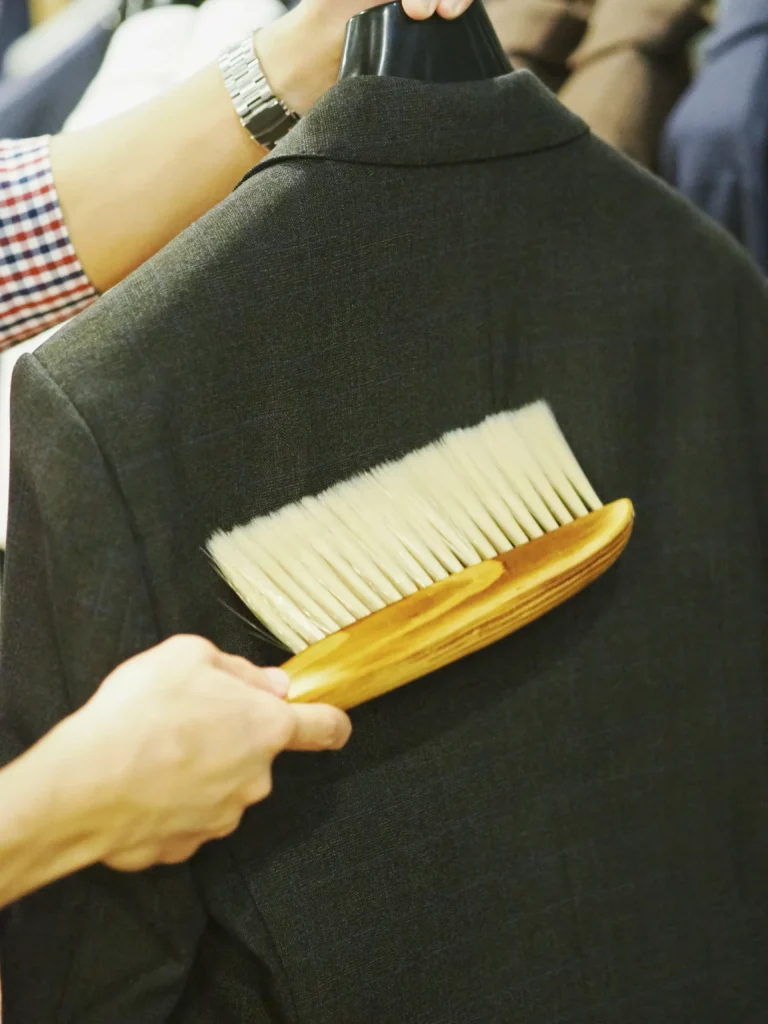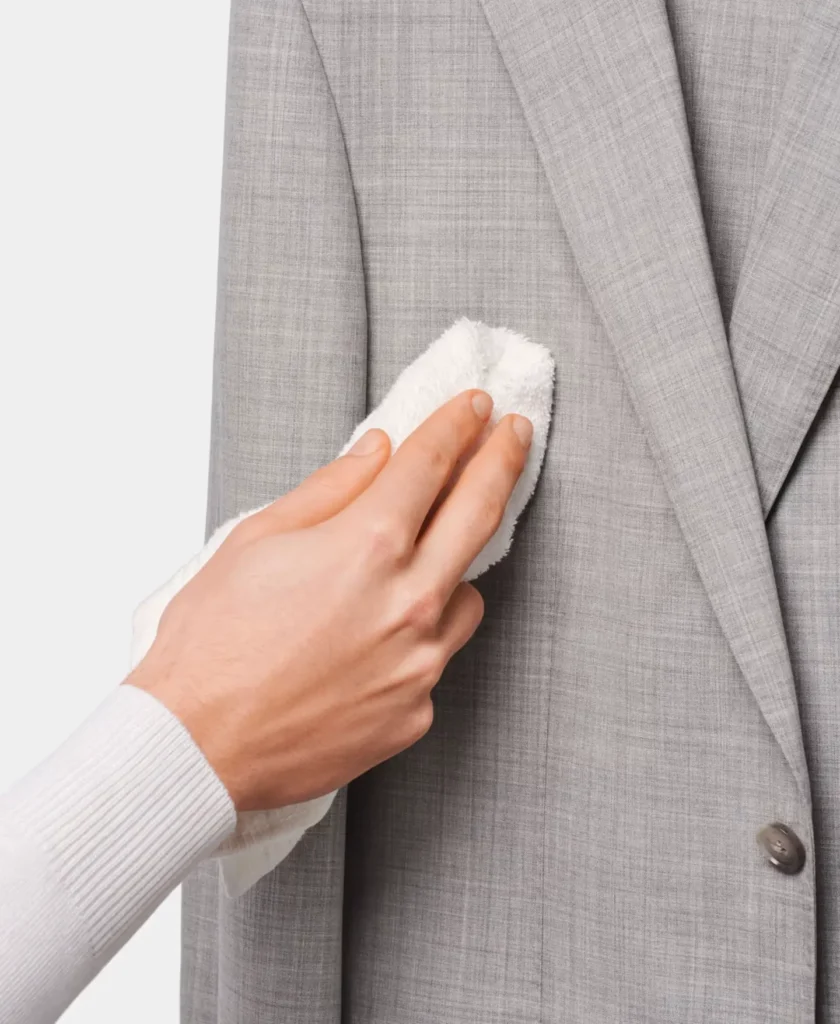A well-tailored suit is more than just a piece of clothing; it’s a statement of style, professionalism, and personal pride. Whether it’s worn for work, weddings, church services, or formal occasions, your suit deserves intentional care to keep it looking sharp and structured for years.
Unfortunately, many people wear out their suits prematurely due to poor maintenance habits, from excessive cleaning to improper storage. Learning how to take care of a suit properly can help preserve its color, fabric quality, and shape, ensuring it continues to serve you well long after your first wear.
In this guide, we’ll walk through simple, effective steps for suit care, including how to clean suits, when to wash or dry clean, how to store them, and how to prevent your favorite ensemble from becoming a worn out suit.
Why Proper Suit Care Matters
A good suit is an investment, not just in your wardrobe, but in how you present yourself to the world. Every time you put on a suit, you’re showcasing your attention to detail, your style, and your personal brand. That’s why caring for your suit should never be an afterthought.
Neglect can turn a fine suit into a worn out suit far too quickly. Fabric may fade, stitching may loosen, and the shape may begin to sag. This doesn’t happen overnight, but through small acts of carelessness, leaving the suit crumpled after use, cleaning it too often, or hanging it on the wrong type of hanger.
Proper suit care isn’t complicated, but it requires consistency. When you take the time to clean, store, and rotate your suits the right way, they maintain their original structure and sharp appearance. More importantly, intentional maintenance helps you avoid unnecessary expenses from frequent replacements.
By learning how to take care of a suit, you not only extend its life but also protect your image, because people often notice the details, even the ones you might overlook.
How Often Should You Clean Your Suit?
One of the most common mistakes people make with suits is over-cleaning them. It might seem like a good idea to dry clean a suit after every wear, but doing so can actually damage the fabric over time. The key is knowing when a suit really needs cleaning, and how to clean suits the smart way.
If you wear your suit occasionally, for a few hours at a time, you don’t need to clean it after every use. Instead, air it out after wearing. Hang it in a well-ventilated area (not a packed wardrobe) for a few hours to allow any trapped moisture, body odor, or smoke to dissipate naturally.
On the other hand, if you’re wearing a suit regularly, say, multiple times a week, it’s reasonable to clean it every 3 to 5 wears. Even then, it’s best to use a soft brush or lint roller to remove surface dust and debris before resorting to dry cleaning.
Why is this important? Traditional dry cleaning uses chemicals that, over time, can weaken fibers and dull the fabric’s original sheen. So, while it may seem like the best way to clean a suit, dry cleaning should be done sparingly.
Instead, focus on spot cleaning, gently removing minor stains with a damp cloth and mild detergent. Reserve full dry cleaning for times when the suit is visibly dirty, carries a strong odor, or has stains you can’t manage at home.
Understanding how often and how best to clean a suit helps it retain its structure, color, and sharpness, so you can keep looking your best without wearing the suit out too soon.
How to Clean a Suit at Home (Without Ruining It)
Cleaning a suit doesn’t always mean a trip to the dry cleaner. With a few simple tools and techniques, you can refresh and maintain your suit at home, safely and effectively.
1. Use a Suit Brush for Surface Dirt
Dust, lint, and food particles tend to cling to suit fabric. A soft-bristled suit brush is a valuable tool for keeping your suit looking clean between wears. Gently brush in short strokes, moving in the same direction as the fabric weave. This simple habit keeps your suit fresh and prevents buildup that can dull the material over time.

2. Steaming vs. Ironing
Wrinkles are inevitable, but how you deal with them makes all the difference. Steaming is the safest way to remove wrinkles from a suit. A hand-held garment steamer helps relax the fibers without direct heat or pressure. Unlike ironing, it won’t create shiny spots or damage delicate materials.
If you must use an iron, place a cloth between the suit and the iron, and set it to the appropriate temperature for the fabric type. Press gently, never drag, and avoid the lapels and shoulders, which can easily lose their shape.
3. Spot Cleaning for Minor Stains
Learning how to clean a suit includes knowing how to handle small spills or stains. Dab (don’t rub) the stained area with a clean cloth dampened with water or a mix of water and mild soap. For oil-based stains, cornstarch or talcum powder can help absorb the grease before blotting. Always test any cleaning method on a hidden area of the suit first.

4. Airing Out After Each Use
Even if a suit doesn’t look dirty, it collects body oils, sweat, and environmental odors. Hang your suit in an open, dry space after each wear to let it breathe and release any odors. This simple step helps reduce the need for frequent cleaning.

5. Use a Lint Roller
Lint, hair, and fuzz can stick to your suit and make it look untidy. A good lint roller removes these in seconds and keeps the fabric looking polished. This is especially useful for dark-colored suits that show lint more easily.
By incorporating these at-home suit care habits into your routine, you’ll keep your wardrobe looking clean, sharp, and professional, without putting it through unnecessary stress.
Understanding Dry Cleaning: Do’s and Don’ts
Dry cleaning is often the go-to method for refreshing a suit, but it shouldn’t be your first or only option. Knowing when and how to use dry cleaning is essential for protecting your suit from early wear and tear.
Do: Dry Clean Only When Necessary
Most suits can go several wears before needing a professional cleaning, especially if you’re following basic maintenance like brushing, airing out, and spot cleaning. Dry cleaning too often exposes the fabric to harsh chemicals, which can break down fibers, cause fading, and leave the suit looking flat.
As a general rule, dry clean your suit every 3 to 6 wears, or after any event where it’s been heavily exposed to sweat, strong odors, or noticeable stains.
Don’t: Trust Just Any Dry Cleaner
Not all dry cleaners handle suits with the same level of care. A poor job can lead to discoloration, misshaped shoulders, or even shrinkage. Choose a cleaner with experience in handling fine or tailored garments. Ask how they treat delicate fabrics and if they use eco-friendly or gentler solvents.
Do: Check Labels First
Always read the care label inside your suit jacket or trousers. Some suits are made from materials that require special handling, like wool, silk, or linen blends. The label will indicate whether the suit is “dry clean only” or if alternative cleaning methods are acceptable.
Don’t: Leave Your Suit in the Plastic Cover
After picking up your suit from the cleaner, remove the plastic cover immediately. These covers trap moisture and chemicals, which can damage the fabric and lead to mold or mildew. Hang the suit in a breathable garment bag instead.
Do: Communicate Stains Clearly
If you’re taking your suit in because of a stain, point it out to the cleaner and let them know what caused it. The sooner and more accurately they know, the better chance they have of treating it without harming the material.
Dry cleaning, when done correctly and at the right time, is one of the best ways to clean a suit, especially when deep cleaning is needed. But when overused or done carelessly, it can be the very thing that leads to a worn out suit. Use it wisely.
How to Wash Suits (If Applicable)
Not every suit requires professional dry cleaning, especially with more casual or modern suit fabrics that are designed to be machine- or hand-washable. However, knowing how to wash suits properly is critical to avoid damaging their shape, structure, or color.
1. Identify the Fabric First
Before you attempt to wash any suit, check the care label. Suits made of wool, tweed, linen, or silk blends usually require dry cleaning only. However, some suits, especially those made from polyester or cotton blends, can be washed at home.
Stretch suits, travel suits, and sweat suits (made for comfort and style) are often washable. Understanding the material will help you determine the safest way to clean it.
2. Washing a Sweat Suit
Sweat suits, typically made of cotton, jersey, or polyester, are more forgiving than formal suits. Here’s how to clean a sweat suit without causing damage:
- Turn it inside out before washing to reduce fading and lint.
- Use cold water and a gentle detergent.
- Select the delicate or gentle cycle on your machine.
- Avoid fabric softeners that may break down moisture-wicking fibers.
- Air dry instead of using a dryer to prevent shrinking and maintain shape.
Learning how to clean a sweat suit properly keeps it soft, durable, and ready for casual or athleisure wear.
3. Machine Washing a Casual Suit (If Allowed)
If your suit’s care label says it’s machine washable:
- Place it in a mesh laundry bag to protect buttons and stitching.
- Wash using cold water on a gentle cycle.
- Use mild detergent (no bleach or harsh cleaners).
- Never wash with heavy garments like jeans or towels.
4. Hand Washing a Suit
If you’re unsure about machine washing, hand washing is the safer alternative for casual suits:
- Fill a clean basin with cold water and mild detergent.
- Submerge the suit, gently swishing it around without wringing or twisting.
- Rinse thoroughly, then press out excess water with a towel.
- Hang on a padded hanger to air dry.
5. Never Wash Formal Suits at Home
No matter how tempting it is, formal suits with structured shoulders, canvassed jackets, or delicate fabric should never be washed at home. Even small mistakes can ruin their shape permanently.
The best way to clean a suit, especially a tailored one, is dry cleaning when needed, supported by good everyday care and minimal handling.
By distinguishing between formal and casual suits, and knowing how to wash suits based on their fabric and structure, you’ll avoid the common mistakes that lead to early damage or a worn out appearance.
Suit Storage Tips
Proper storage is one of the most overlooked parts of suit care, yet it’s one of the most important. Even the best-tailored suit can lose its shape, structure, or sharpness if not stored correctly. Taking a few intentional steps ensures your suits stay crisp and ready-to-wear, not crumpled, faded, or forgotten.
1. Use the Right Hanger
Always hang your suit on a wide, curved hanger that supports the shoulders and helps maintain the jacket’s natural form. Thin wire hangers can distort the shape over time and create unsightly shoulder dimples. Wooden or padded hangers are ideal for suit jackets, while trousers should be hung using a clip or bar-style hanger to prevent creases.

2. Avoid Overcrowded Closets
Give your suits room to breathe. Stuffing them between tightly packed clothes causes wrinkles, folds, and friction, which can wear out the fabric. Leave enough space on either side of the suit to allow the fabric to hang freely and maintain its shape.
3. Use Garment Bags for Long-Term Storage
If you’re not planning to wear a suit for a while, such as a seasonal or special-occasion piece, store it in a breathable garment bag. Avoid plastic covers that trap moisture and encourage mildew or discoloration. Instead, opt for cloth garment bags that allow air to circulate while protecting your suit from dust and moths.
4. Store in a Cool, Dry Place
Keep your suits away from direct sunlight, which can fade the fabric, and avoid damp or humid areas that encourage mold. A cool, dry wardrobe with good ventilation is ideal for preserving both the appearance and quality of your suit.
5. Freshen Before Storing
Before putting a suit back in your wardrobe, ensure it’s clean, brushed, and aired out. Even invisible traces of sweat or perfume can settle into the fabric and cause long-term damage or unpleasant odors if left untreated.
6. Travel Storage: Folding Suits Without Wrinkles
If you need to pack a suit in luggage:
- Turn the jacket inside out and fold it shoulder-to-shoulder, tucking one shoulder into the other.
- Lay the folded jacket flat, then place the trousers inside and fold everything together carefully.
- For wrinkle-free travel, consider using a suit travel bag or a garment folder.
Suit storage is not just about where you hang your suit, it’s also about how you handle it before and after every wear. With the right tools and a little extra care, you can extend the life of your suit and keep it looking sharp every time you put it on.
Everyday Suit Maintenance Tips
Taking care of your suit doesn’t have to be time-consuming. In fact, it’s the small, consistent habits that keep your suits in top condition. Incorporate these simple routines into your daily and weekly schedule, and you’ll avoid premature damage and the dreaded worn out suit look.
1. Rotate Your Suits
Avoid wearing the same suit multiple days in a row. Fabric needs time to rest and breathe. By rotating between suits, you reduce stress on the material and allow natural moisture (like body sweat) to evaporate fully between wears. This simple habit extends the lifespan of every piece in your wardrobe.
2. Empty Pockets After Every Wear
Always check and empty your pockets before hanging your suit. Leaving items like keys, wallets, or phones can stretch the fabric and ruin the suit’s silhouette over time. It also helps the suit hang naturally and evenly when stored.
3. Brush It Down Regularly
A quick once-over with a suit brush after each wear helps remove dust, lint, and debris that accumulate throughout the day. Brushing not only keeps the fabric clean but also revives the texture and finish of materials like wool or tweed.
4. Use a Lint Roller When Needed
For quick touch-ups, especially on dark or textured fabrics, a lint roller is your best friend. It instantly removes hair, fuzz, or particles and ensures your suit always looks polished and professional.
5. Air It Out
Hang your suit in an open space for a few hours after each wear. This allows trapped body heat and moisture to dissipate and helps eliminate light odors. It’s a natural refresher, no sprays or scents needed.
6. Don’t Overuse Cologne or Deodorant
While smelling good is important, heavy sprays of cologne or strong deodorants can seep into the fabric and be hard to remove. Over time, they can create unpleasant chemical blends or even discolor the lining. Spray lightly and let it settle on your skin before putting on your suit.
7. Address Wrinkles Gently
If you notice minor wrinkles, use a handheld steamer to smooth them out. Avoid pressing hard with an iron unless absolutely necessary, and always use a protective cloth between the fabric and the heat source.
Consistency is key when it comes to suit care. By making these steps part of your regular routine, you’ll preserve the elegance and structure of your suits and avoid the costs and frustration of early replacement.

How to Identify a Worn Out Suit
No matter how well you care for your suit, there will come a time when it starts showing signs of age. Knowing when your suit has reached the end of its prime can help you avoid the embarrassment of looking untidy and help you plan a timely replacement.
Here’s how to spot a worn out suit:
1. Fading or Discoloration
One of the first signs of a tired suit is fading, especially around the shoulders, elbows, knees, and seams. This often results from overexposure to sunlight, repeated dry cleaning, or general wear. A once-rich navy or charcoal suit may begin to look dull and uneven in color.
2. Thinning Fabric
Gently run your hand over high-contact areas like the seat of the trousers or under the arms. If the fabric feels thin, rough, or slightly see-through, it’s a sign that the fibers are breaking down. Continued use could lead to tearing or holes.
3. Sagging or Misshapen Structure
A well-constructed suit should hold its shape, especially in the shoulders, chest, and lapels. If your jacket begins to droop, look uneven, or lose its defined lines, the internal structure (often made of canvas or interfacing) may have weakened. This can’t be easily fixed.
4. Permanent Wrinkles
Occasional wrinkles are normal, but when a suit stops responding to steaming or pressing, it may have become permanently creased. This usually happens when a suit is repeatedly folded or stored incorrectly, causing the fabric to lose its memory.
5. Damaged Lining
Check the inside of the jacket and trousers. Torn, stained, or fraying linings are not only uncomfortable, they’re also signs of heavy wear. While minor lining repairs are possible, significant damage often isn’t worth fixing.
6. Stretched or Loose Seams
If you notice puckering, pulling, or open seams at the shoulders, crotch, or waistband, it’s a sign your suit may no longer fit properly or is too worn to hold together. Ignoring this can lead to wardrobe malfunctions in public settings.
7. Stubborn Odors
Over time, sweat, cologne, and environmental odors can cling to a suit, especially if not cleaned properly. If your suit still smells musty or sour even after dry cleaning, it may be beyond saving.
When to Let Go
If multiple signs appear at once, thinning fabric, sagging fit, and visible wear, it may be time to retire your suit. Don’t view it as a loss; see it as a sign that you got great use out of a valuable wardrobe piece.
You can always repurpose a worn out suit for less formal occasions, donate it, or use the fabric creatively. But for formal, business, or special events, it’s best to invest in a fresh, well-fitted replacement.
Conclusion
Caring for a suit is not just about keeping it clean; it’s about preserving the fabric, structure, and style that make it a timeless piece in your wardrobe. From knowing how to clean a suit the right way, to storing it properly, brushing it down after wear, and identifying when it’s time to retire an old one, every step matters.
When you understand how to take care of a suit, you extend its life and keep it looking sharp wear after wear. You avoid the frustration of a worn out suit and the unnecessary cost of frequent replacements. Whether it’s your formal business attire or a more relaxed sweat suit, intentional care is the secret to maintaining that fresh, confident look.
Remember, it’s not about doing everything at once; it’s about building small, consistent habits that keep your suits in top shape. Respect the craftsmanship of your clothing, and it will reward you with years of dependable elegance.

